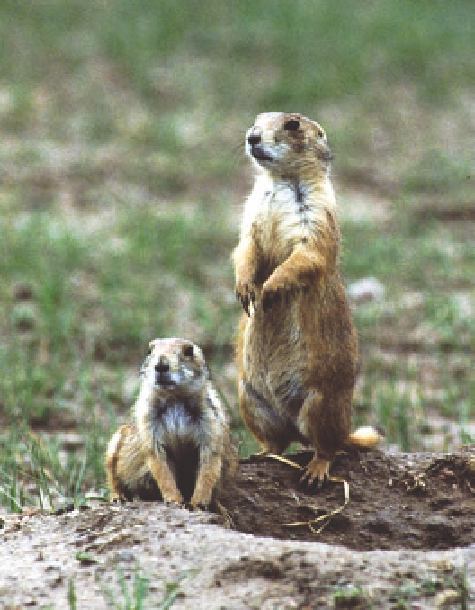Geoscience Reference
In-Depth Information
ing for the gophers often amplify the effect with their
digging. this burrowing moves tons of soil every year,
helping to create a more friable soil structure that has
long-term benefits for plant growth. Pocket gopher
burrows provide habitat for the grasshopper mouse, as
well as the beetles and crickets on which the mice feed,
and though the gopher is nocturnal, some individuals
that make the mistake of coming to the surface dur-
ing daylight provide food for raptors. notably, pocket
gophers tend to occur near clumps of pricklypear cac-
tus, possibly because the succulent cacti serve as a
source of water. the gophers are able to eat around the
spines.
the most studied burrowing mammal in grasslands
is the prairie dog fig. 6.13; see also fig. 6.9). two species
are found in Wyoming, the black-tailed prairie dog on
the Great Plains and the white-tailed prairie dog of the
intermountain basins. one of the most obvious effects
of prairie dogs is the extensive burrowing that character-
izes their colonies (towns). As with pocket gophers, large
volumes of soil are moved, improving infiltration, has-
tening the incorporation of organic matter, facilitating
Generally, prairie dog burrows are dug to depths of 3-9
feet, deeper than pocket gophers. Along with the pocket
gopher and other burrowing mammals, prairie dogs
enable a higher level of biological diversity by creating a
variety of subterranean habitats, such as for burrowing
owls, rattlesnakes, grasshopper mice, desert cottontails,
reptiles and amphibians, which in turn encourages the
raptors that feed on such animals (most commonly the
ferruginous hawk). Large colonies also provide habitat
for the restoration of black-footed ferrets, which depend
chapter 4), prairie dogs influence grassland ecosystems
more than expected based on their low biomass—the
definition of a
keystone species.
Because beaver and bur-
rowing mammals play such a deliberate role in creating
their habitat, they are also known as
ecosystem engineers.
in addition to extensive burrowing, the black-tailed
prairie dogs on the Great Plains keep the surrounding
vegetation clipped close to the ground, even if they don't
eat it—presumably to improve their ability to detect
stalking predators (see chapter 16). this clipping leaves
the impression of an overgrazed rangeland, which has
led some to doubt that their effects on the rangeland are
Fig. 6.13. Prairie dogs, along with other burrowing animals
(such as Richardson's ground squirrels, badgers, and harvester
ants), alter vegetation structure on the grasslands and shrub-
lands of the intermountain basins and western Great Plains.
their burrows can be 6 feet deep or more. the black-tailed
prairie dog, shown here, is found at lower elevations on the
western Great Plains; the white-tailed prairie dog is found
in the intermountain basins to the west. Photo by LuRay
Parker / Wyoming Game and Fish Department.
favorable. However, research suggests that large prairie
dog populations are a symptom of heavy livestock graz-
ing. they reason that prairie dog densities increase with
heavy grazing because predator success is diminished,
due to less plant cover around the town. Moreover,
heavily grazed rangelands commonly have more forbs,
which are preferred by the rodents, and by pronghorn,
too. the interaction of clipping, grazing, and predation
may be less likely in shortgrass prairie, where the veg-
etation is already short and visibility good.
Although prairie dog towns add significantly to the
biological diversity of the grasslands where they occur,
they also appear to reduce the amount of livestock for-
age. Moreover, some of the land is pockmarked with
their burrows, creating a hazard for livestock and horse-
back riders alike. consequently, like wolves, the rodents
are most often viewed as problem animals where live-

Search WWH ::

Custom Search